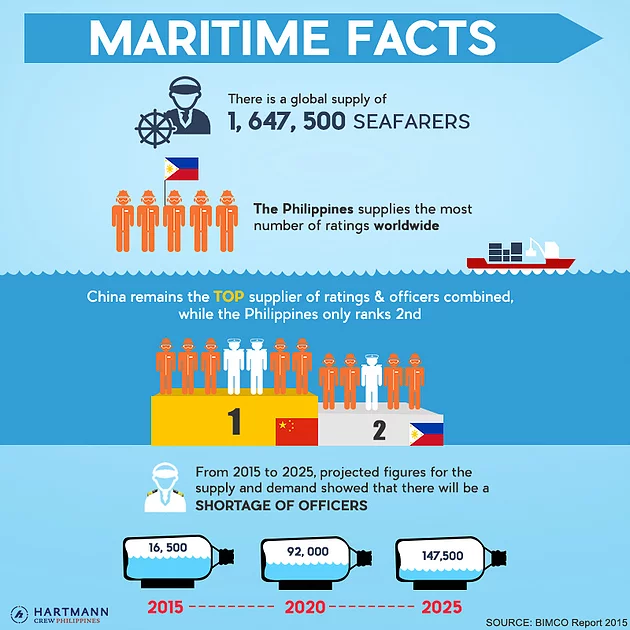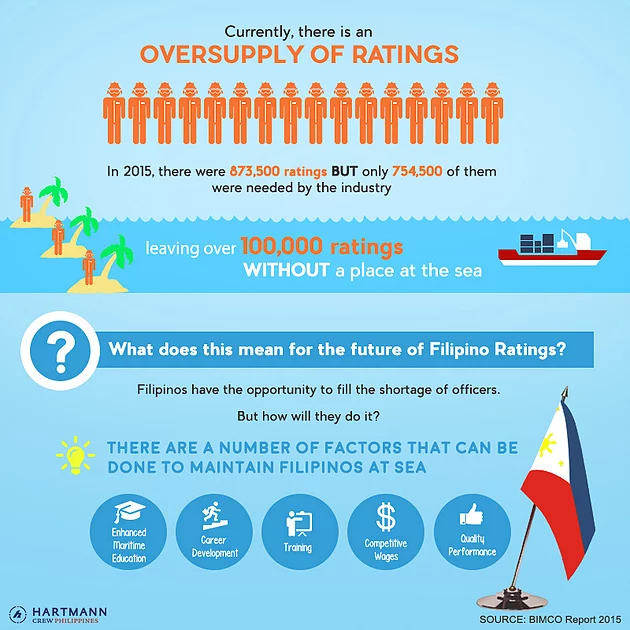News
Find out what's new at Hartmann Crew Philippines
For press inquiries and concerns, please contact the Corporate Communications office of Hartmann Crew Philippines.
Email: ccfc@hartmannph.com
MARITIME FACTS FROM THE 2015 BIMCO REPORT What challenges exist for the Philippine Crewing Industry?
The Baltic and International Maritime Council, popularly known as BIMCO recently released their 2015 Manpower Report on the global demand and supply of seafarers.
The team at Hartmann Crew Philippines summarized a portion of the data and brought it to the local level. We asked ourselves: What do these numbers mean for Filipino Seafarers?

Globally, there are 1,647,500 seafarers inclusive of both officers and ratings. Out of all these seafarers, The Philippines provides the largest number of ratings.
Despite the large number Filipino ratings, the country only ranks number two—next to China—as the world’s largest provider of seafarers across all ranks.
The BIMCO report also projected that from 2015 to 2025 there will be a continuous shortage of officers. Last year, there was an estimated shortage of 16,500 officers. By 2020, the shortage is expected to reach 92,000, and will hit 147,500 by 2025.
As for ratings, the story is the opposite—there is an oversupply. In 2015, there was an estimated number of 873,500 ratings worldwide but only 754,500 of them were need by the industry. This left over 100,000 ratings without a place at sea.

For a country like the Philippines, what do these figures mean—especially for the large number of Filipino ratings?
The lack of officers presents an opportunity for Filipino ratings to move up the ranks and fill in the projected shortage. However, this move must be done alongside different factors in order to help maintain Filipinos at Sea:
-
Enhanced Maritime Education – Better foundations from educational institutions will ensure that future maritime professionals are equipped with the right knowledge.
-
Career Development – Agencies employing seafarers must take an active part in developing the careers of its crew in order to contribute to their growth as professionals.
-
Training – Continuous learning is crucial. Technology onboard ships change rapidly and seafarers going up the ranks must learn to keep up. It’s also an advantage for seafarers to deepen their knowledge on the changing economics and multi-cultural aspects involved in the shipping industry.
-
Competitive Wages – Filipinos face competition from other nationalities for a place onboard. With the current downtrend of the economy, ship owners are least likely to pay for higher wages when more competitive rates are present elsewhere.
-
Quality Performance – There is no substitute for quality. Filipino crew must continue to deliver excellent work and service in order to cement their place in the industry and to justify the cost of employing them onboard ships.
The reality is that there is a challenge at hand for the Philippine Maritime Industry. A challenge that can turn into an opportunity if the seafarers together with the administration and the rest of the industry players are willing to augment the system and integrate these factors in order for the Philippines to become the first choice of highly qualified maritime professionals regardless of rank.
Do you have thoughts on the matter? Let us know what you think and what can be done. Join the conversation online at www.facebook.com/hartmannph.
C a t e g o r y
Career (35)
COVID-19 (4)
Event (47)
Family (18)
Features (23)
Health (10)
Industry (36)
ISNTC (8)
MMPC (12)
News (66)
Videos (7)
A r c h i v e
March 2024 (1)
February 2024 (2)
January 2024 (2)
October 2023 (2)
June 2023 (2)
March 2023 (1)
February 2023 (1)
January 2023 (2)
October 2022 (2)
August 2022 (1)
July 2022 (1)

